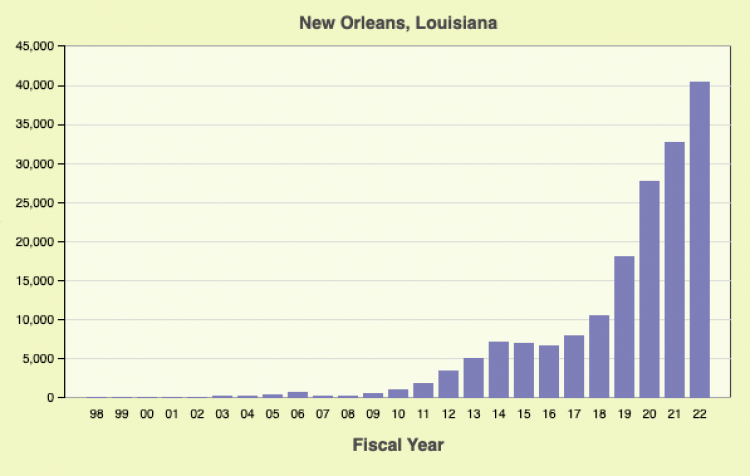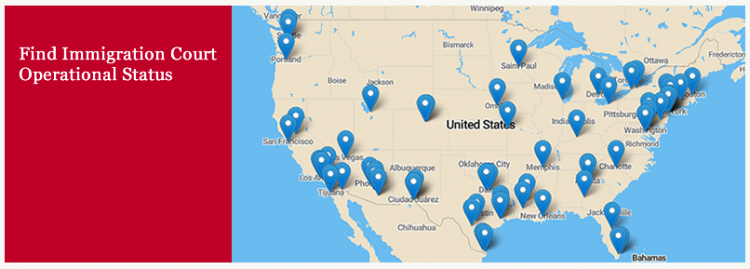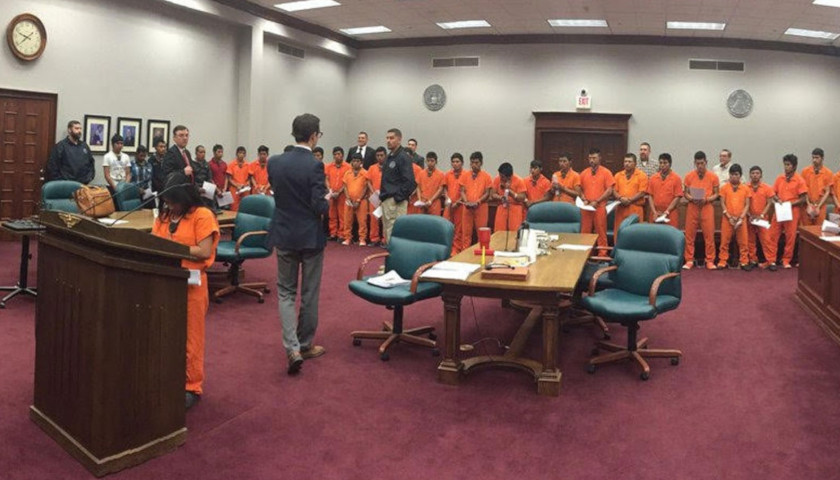by James Varney
NEW ORLEANS—The courtrooms handling illegal immigration cases here are tucked into the fifth floor of a white skyscraper on the bank of the Mississippi River. A few floors below is a Saks Fifth Avenue, reputed to be one of the tony department store’s most profitable locations, and a few floors above is a U.S. passport office so busy admittance is barred without an appointment.
The New Orleans immigration courts have none of that bustle. Over five days during a two-week period in June that officials described as typical this year, two active courtrooms heard about 50 combined cases each morning, wrapping up business by 11 a.m. even though all those cases were continued.
The brief activity seemed puzzling for a system that all sides of the immigration debate agree has been overwhelmed by a growing national backlog of at least 1.8 million cases. For the New Orleans courts, the backlog currently stands at more than 40,000 cases, according to the Transactional Records Access Clearinghouse, or TRAC, at Syracuse University, which focuses on immigration topics. But the darkly wooded courtrooms — featuring the Department of Justice seal on to the wall behind the judge (photography not allowed) — feel more like a sleepy municipal outpost than one of the key cogs in a national crisis.

The day begins around 8:30 a.m. Handfuls of immigrants, very few of whom have lawyers – which will turn out to be a wise legal strategy – walk down an unmarked hallway typical of corporate office space. After buzzing to open the door, they pass through a metal detector into a small, windowless waiting room reminiscent of a Department of Motor Vehicles office. There are some 30 hard plastic chairs bolted in rows, and behind a thick glass panel on one wall a secretary is intermittently at work. On a back wall, hanging limply over the edge of plastic pockets, are stapled copies, in English and Spanish, of advice for immigrants, including, from the Department of Homeland Security, “Have You Been A Victim of Trafficking?” and “What if You Disagree with the Judge’s Decision?”
The immigrants coming to court are a fairly even mix of men and women. Some are accompanied by children; some clutch a few sheets of paper, usually their “Notice to Appear,” the first official document they receive from the United States, either when they first entered the country or got in the mail if they had a fixed address. They are then usually assigned to one of the 66 stateside immigration court locations nearest them. In one sign of the backlog, several of the immigrants had forms issued to them in March 2021.
“When I started practicing immigration law in Baton Rouge in 2007,” said Ken Mayeaux, one of Louisiana’s top immigration attorneys and former clinical professor at LSU Paul M. Hebert Law Center, “there was only one immigration judge in New Orleans and at that time, from initial hearing to final decision, was typically four to six months. Now it’s more like four to five years.”
The immigrants take their seats among a handful of wooden pews. A mask requirement was lifted on June 24, but attendance is sparse enough to allow ample social distancing in the audience.

These morning procedures are what are known as “master calendar” hearings. On most days, given that everyone is going through the same procedure and few of the immigrants speak much, if any, English, the sessions begin like a dubbed movie. As the judge quietly runs through the legal boilerplate that applies to all first appearances, a translator stands in front delivering, much more loudly, the same legalese in Spanish.
They are then called up one by one. The immigrant dons the translating headphones at one table. Speaking rapid-fire, the judge whips through the fact the immigrant has come to the United States apparently illegally.
Sometimes something more than Spanish is required. In those cases, the judge phones in to a private business that offers translators, swears them in over the speakerphone and business flows as normal. On one morning, U.S. immigration judge Joseph La Rocca called in translators for two languages – Arabic and K’iche, an indigenous Mayan tongue.
“About typical,” La Rocca said after clearing the 25 “master calendar” cases listed on his docket. “Sometimes it does feel like we have the United Nations here.”
The charges regarding illegal entry are quickly conceded. The judge then concludes the immigrant is “removable” and a country of return is requested. At times the immigrant will specify, “Honduras,” say, or “Mexico.” Should a country of return not be offered, the government’s attorney will specify one, uttering some of the few words they speak throughout the morning sessions.
But that is not the end of the matter. Those who do not have a lawyer, which was almost everyone in court the days RealClearInvestigations attended, get a reprieve – usually a four-month stay to allow time to find an attorney and be placed back on the “master calendar” to sit through the process once again. Immigrants are not entitled to representation, although the court does make available a list of nonprofit clinics that can offer legal advice.
A more substantive hearing will be required later, generally where immigrants can press claims for asylum. Those hearings, which usually take place in the afternoon in New Orleans, are rarely public. Although the morning numbers of cases would suggest busy afternoons, on the days RCI visited the court, there was only one afternoon when two such hearings were scheduled and no one showed up for them. Several attorneys said that indicates they were dismissed.

The lack of activity in June was unusual, according to attorneys who practice in immigration court. They also said additional “master calendar” hearings are held by video, and that many days there is a separate room where the court will hear dozens more initial appearances. “It may look like nothing is going on but believe me, there is a lot going on,” Mayeaux said. “But this is an abnormal time.”
TRAC of Syracuse attributes much of the slowdown to the COVID pandemic, but another main cause according to attorneys is what the Biden administration calls “prosecutorial discretion,” which it has increasingly used to wipe clear cases against illegal immigrants.
The policy involves the government’s lawyers in court, part of Immigration and Customs Enforcement, simply dropping the cases. The new policy to unclog the system by letting illegal immigrants walk came from the so-called “Doyle Memorandum,” an internal guidance memo issued by DHS’ Principal Legal Adviser Kerry E. Doyle that went into effect April 25.
Under its terms, the government makes an “unopposed motion to dismiss without prejudice … recipients who have been ordered removed or deported from the United States and are seeking to apply for lawful permanent residence with U.S. Citizenship and Immigration Services.”
“You are free to go and live your life, and the government has no interest in removing you from the country,” Judge Charlotte Marquez told an immigrant in New Orleans accepting “prosecutorial discretion,” adding those terms could change should there be some future lawbreaking.
The Doyle Memorandum is tied to a series of memos DHS crafted in 2021, culminating in one from Secretary Alejandro Mayorkas last Sept. 30 that crafted new categories for illegal immigrants on whom the administration said it would concentrate its deportation efforts.
But states have successfully sued DHS over those terms, in federal lawsuits including, as one of their core arguments, that Mayorkas does not have “prosecutorial discretion” in matters on which Congress has passed clear mandates.
DHS declined to provide figures to RealClearInvestigations on how many people have received “prosecutorial discretion” since the Doyle Memorandum took hold, or to offer comment on its legal basis.
“Statistics are not available at this time,” an agency spokesperson told RCI, pointing to the web page that offers general information about its “prosecutorial discretion,” which appears to have been available to any illegal immigrant ICE deemed “non priority.”
At the end of June it appeared the Biden administration would suspend the policy after it lost a lawsuit filed by Texas and Louisiana, but the practice has continued, albeit less comprehensively, according to several immigration attorneys.
The resort to prosecutorial discretion seemed inevitable in a situation where the system is overwhelmed by its caseload and its judges are appointed by the attorney general and largely serve at the AG’s pleasure, said Tony Rogers, who stepped down from the immigration bench in a Texas court in 2009.
“I’m not the greatest fan of how things are run now,” Rogers said. “And I’m hyper-concerned now with the volume they have. The measure of efficiency now is strictly numbers, that is, how many cases are you completing in a month?”
What is happening in New Orleans is but a tiny sliver of the nation’s immigration court system trying to handle what has become a crush on the southern border so severe that on July 5 several Texas counties declared they were under invasion.
U.S. immigration courts have a global reach – there are two judges based in Saipan, part of the Northern Mariana Islands, a U.S. commonwealth in the Western Pacific, added to those across 28 states and Puerto Rico. As might be expected, heavily populated coastal cities or border states have the most. In Texas, for instance, there are 100 judges on benches in 13 places. New York City alone has 71 immigration court judges operating in Manhattan and Brooklyn. Los Angeles, one of 10 California locations, has 35 judges, according to the Executive Office for Immigration Review (EOIR). The total means Los Angeles eclipses the 25 judges in San Francisco and the 18 in Santa Ana, making it the largest California location.
All told, it takes at least 535 immigration judges in 66 stateside locations plus three outside “adjudication centers” to address the migrant challenge, according to the Office of the Chief Immigration Judge.
As might be expected, none of this comes cheaply to taxpayers. The immigration court system’s budget has exploded in recent years, growing from $504 million in fiscal 2019 to a request for $891.19 million in fiscal 2022, an increase of 57%, according to federal figures.
Much of that increase is attributable to personnel. In fiscal 2019, EOIR had 2,798 full-time positions and 1,201 lawyers. By 2022, staffing had swelled to 4,361 “permanent positions” along with 2,921 “full time equivalent (FTE)” positions, a rise of 55% in three years, according to public figures.
TRAC’s figures show U.S. immigration courts have become more friendly for illegal immigrants under the Biden administration. For example, the “relief” granted by immigration judges has hit a record high in FY2022.
The number of cases in which a judge “found the original charges sustained but also found provisions in the immigration law that entitle an individual to ‘relief,’ from removal, allowing them to remain in this country” rose from 19,935 in fiscal 2021 to more than 36,800 through early July in fiscal 2022, according to TRAC.
Meanwhile, the number of removals ordered has plummeted, according to TRAC. Under President Trump, removals rose from 102,167 in fiscal 2017 to 187,934 in 2019. President Biden took office four months into fiscal 2021, and removals that year fell to 38,258, according to TRAC, which did not respond to requests for comment. That number has climbed in the current fiscal year, but at a pace that will leave it below 100,000.
The odds a “non-citizen” will not be ordered deported have improved dramatically under President Biden. In the 2020 fiscal year, illegal immigrants stood a 70.3% chance they’d be ordered deported, and that figure has now plummeted to 24%, according to constantly updated TRAC charts.
And even if someone is ordered deported, state officials insist those orders aren’t being followed. Arizona Republican Gov. Doug Ducey recently noted there are more than 1 million immigrants with standing deportation orders the Biden administration is making no effort to enforce, a figure state officials confirmed to RealClearInvestigations.
“It’s all become simply a matter of buying time,” Rogers said. “These things used to be around 20-day proceedings and the only people who ever showed up were the Chinese, usually seeking a change of venue to New York. You’d just show the person is not a citizen and an order of deportation would be issued.
“But now you can buy time, at least five to eight years,” he said. “The best thing you can do is buy time, because then the law might change. There might be another amnesty.”
One immigrant who no doubt hopes for an amnesty is Pedro Pablo Alvarez. The 17-year-old recently set out with his father, on foot, from De Boaco, Nicaragua, and after a month-long odyssey wound up before Judge Kevin Guillory.
Alvarez told RCI that despite widespread horror stories about such trips, his journey was not fraught with danger aside from one or two dicey days in Mexico. about which he declined to elaborate. Although crossings at the border are reputed to be controlled exclusively by Mexican cartels, Alvarez doggedly insisted he and his father crossed the border “independently.”
His “master calendar” appearance in New Orleans was like every other, in that Guillory gave him four months to look for an attorney and then scheduled a return appearance for October.
But Alvarez decided to take a chance.
“I don’t know if I should be saying this,” he said, “but I want the court to know. I came from a poor, farm territory and I’m a high school graduate. I came to this country because I want to find a better life for myself and I hope to go to college. Our purpose here is just to do better in life.”
Guillory told Alvarez, “the court appreciated his candor,” and with a caveat that his words were not a promise did his best to assure the earnest young man.
“If there’s any way at all the court can grant you relief it will, and the court will look at every possible avenue to grant you relief,” Guillory said.
– – –
James Varney is a writer for RealClearInvestigations.





